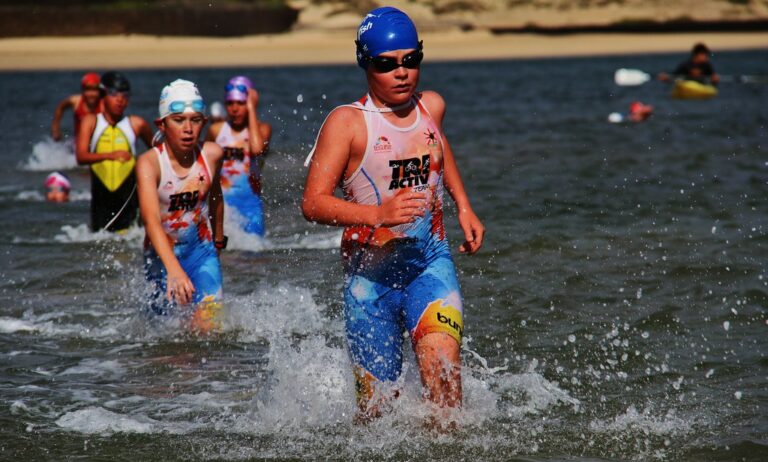General Rules of Relay Swimming
Plunge into the synchronized rhythm of relay swimming, where each stroke symbolizes teamwork and precision. As you take your mark, understanding the general rules is important for a seamless race. From the composition of your relay team to the etiquette of finishing a race, each aspect plays a essential role in the success of your team. Stay tuned to discover the intricate details that can make or break your relay performance.
Relay Team Composition
When forming a relay team for swimming, make sure that each member's strengths complement the others to optimize performance. The team order dynamics play a critical role in determining the success of the relay. Understanding the anchor leg strategy is essential as the final leg can often determine the outcome of the race.
In relay swimming, the order in which team members swim is important. The fastest swimmer may not always go first; strategic placement based on individual strengths is key. Consider factors like starts, turns, and finishes when arranging the team order. Relay handoffs are another critical aspect. Smooth and efficient exchanges can make a significant difference in the overall time. Practice relay handoffs diligently to perfect this skill.
Additionally, mastering relay anchor techniques is important. The anchor leg swimmer must have a combination of speed, endurance, and mental toughness. This swimmer needs to maintain or increase the lead established by the previous team members. Strategic pacing and a strong finish are crucial for the anchor leg swimmer.
Exchange Zone Regulations
As you consider the Exchange Zone Regulations in relay swimming, it's important to focus on the timing in exchanges and the coordination within the relay team. Understanding the intricacies of when to start your approach and execute the handoff can make a significant difference in your team's performance. Maintaining clear communication and precise movements during exchanges are key elements that can lead to success in relay events.
Timing in Exchanges
Understanding the intricacies of timing within exchanges is important for relay swimmers to adhere to exchange zone regulations effectively. Split times and accuracy play a critical role in determining successful exchanges. When executing relay exchanges, the relay order and strategy should consider each swimmer's strengths to maximize performance. To help you understand the significance of timing within exchanges better, refer to the table below:
| Aspects of Timing in Exchanges | Description | Importance |
|---|---|---|
| Split times | Record individual times | Evaluate performance |
| Accuracy | Precise timing | Prevent disqualifications |
| Relay order | Determine swimmers' order | Optimize performance |
| Strategy | Plan for each swimmer | Enhance overall outcome |
| Exchange zone regulations | Follow specific rules | Ensure fair competition |
Relay Team Coordination
To guarantee smooth relay team coordination, mastering the exchange zone regulations is imperative for swimmers aiming for peak performance. Team strategy and communication play a crucial role in ensuring seamless changes during relay races. Effective communication between teammates is essential to coordinate the timing of exchanges accurately. Each swimmer must trust in their teammates' abilities and be ready to react swiftly within the exchange zone. Team bonding is vital as it fosters trust and enhances coordination, leading to faster relay times. Understanding the rules and regulations of the exchange zone is fundamental for a successful relay team. By practicing exchanges diligently and emphasizing communication and trust, relay teams can achieve optimal coordination and improve their overall performance.
Starting Block Protocols
When it comes to relay swimming, understanding the starting block protocols is essential. You'll need to grasp the relay exchange techniques and be aware of the consequences of a false start. Mastering these points will help your team perform at its best during relay events.
Relay Exchange Techniques
Consider refining your relay exchange techniques by focusing on your starting block protocols for a smoother handoff between swimmers. To enhance your relay exchanges, pay attention to the following starting block protocols:
- Efficient Timing: Make sure that your outgoing swimmer starts their approach to the wall at the right moment to meet the incoming swimmer's touch precisely.
- Clear Relay Order: Establish a clear and communicated relay order well in advance to avoid confusion during the exchange.
- Precise Strategies: Develop specific strategies for each leg of the relay to optimize the handoff process and maintain momentum.
- Consistent Practice: Regularly practice relay exchanges to refine techniques, timing, and coordination for seamless transitions between swimmers.
False Start Consequences
For relay swimmers, understanding the consequences of a false start is important to maintaining the integrity of the race and avoiding penalties. False starts can lead to disqualification, costing your team the race. To prevent false starts, make sure you are fully set before the starting signal. False start etiquette dictates that any movement on the block after taking your mark is considered a false start. If a swimmer false starts, not only is their team penalized, but they also face personal repercussions, such as potential disqualification from other events. Hence, it is vital to stay focused, maintain composure, and only react to the starting signal to avoid the severe consequences of a false start.
Transition Turn Techniques
To execute efficient switching turns in relay swimming, you should focus on maintaining momentum and minimizing resistance through proper body positioning and timing. Handoff turn techniques are vital for guaranteeing a smooth exchange and maximizing your team's performance. Here are some tips to help you master this aspect of relay swimming:
- Flip Turn Strategies: When approaching the wall for your turn, make sure to tuck into a tight somersault motion, pushing off the wall with strong legs. The quicker and more streamlined your flip turn, the less resistance you'll encounter, allowing you to carry your speed efficiently into the next lap.
- Underwater Push: After executing your flip turn, utilize the underwater phase to its full potential. Glide underwater using strong dolphin kicks and extended arms to propel yourself forward before breaking the surface. This underwater push can give you a significant advantage by maintaining your speed and reducing drag.
- Open Water Exchanges: In open water relay races, practice smooth transitions between swimmers. Timing is key here—make sure to touch hands precisely to ensure a seamless handoff without losing momentum.
- Touch Handoffs: During touch exchanges, focus on accuracy and synchronization. Both swimmers need to coordinate their movements effectively to exchange the baton without any fumbles or delays. Practice this skill regularly to perfect your handoffs and optimize your relay performance.
Disqualification Factors
Understanding the disqualification factors in relay swimming is essential for maintaining the integrity of the competition and ensuring fair play among participants. Common disqualifications in relay races can occur due to various reasons such as early take-offs, improper relay exchanges, and swimmers crossing into another lane. To avoid these penalties, it is critical for relay teams to implement effective relay strategies.
One of the most common disqualifications in relay swimming is when a swimmer leaves the block before their teammate touches the wall during the relay exchange. This early take-off not only leads to disqualification but also impacts the overall performance of the team. To prevent this, precise timing and coordination between swimmers are essential. Proper communication and practice can help perfect the relay exchange, ensuring a smooth handover without risking disqualification.
Another disqualification factor to watch out for is swimmers veering into another lane during their leg of the race. This can happen due to fatigue, lack of focus, or improper technique. To mitigate this risk, swimmers should stay mindful of their position in the lane, especially during turns and when approaching the wall for the exchange.
Incorporating these relay strategies into your team's training regimen can greatly reduce the chances of disqualification and enhance your overall performance in relay swimming competitions.
Race Finish Etiquette
When it comes to relay swimming, observing proper race finish etiquette is essential for upholding sportsmanship and respect among competitors. As you approach the end of a relay race, it's important to remember that how you finish can impact not only your team but also the overall atmosphere of the competition. Here are some key points to keep in mind regarding race finish etiquette:
- Maintain Focus: As you near the end of the race, stay focused on finishing strong. Avoid premature celebrations that could cost your team the win.
- Respect Your Competitors: Show respect to your fellow swimmers by refraining from any unsportsmanlike behavior during the race finish. A display of good sportsmanship reflects positively on you and your team.
- Celebrate Thoughtfully: If your team secures a victory, celebrate with enthusiasm but remember to do so thoughtfully. Be mindful of the other teams and avoid excessive or boastful celebrations that could be perceived as disrespectful.
- Congratulate Others: Whether you win or not, always take the time to congratulate the other teams on their performance. A simple gesture of sportsmanship can go a long way in fostering a positive competitive environment.
Frequently Asked Questions
Can Swimmers Switch Positions Within the Relay Team During the Race?
In relay swimming, swimmers cannot switch positions during the race. Swimmer rotation is vital for team strategy, with each member assigned a specific leg. Changing positions mid-race is not allowed, so plan well!
What Happens if a Swimmer False Starts During a Relay Event?
If a swimmer false starts during a relay event, penalty consequences apply, potentially disqualifying the team. Refine starting block techniques to avoid this. Precision is critical. Stay focused on the relay exchange to guarantee seamless shifts and success.
Are There Any Specific Rules Regarding the Order in Which Swimmers Must Swim in a Relay Event?
In relay swimming, the order is like a puzzle, each piece essential for success. Strategize wisely; your team's tactics determine victory. Relay order isn't random; it's the blueprint for achieving greatness in the pool.
How Are Relay Teams Typically Selected for Competitions?
When selecting relay teams, coaches consider performance, chemistry, and individual strengths to maximize success. Strategic decisions like lead-off, anchor positions, and training techniques contribute to team dynamics and overall performance in competitions.
What Should Swimmers Do if They Accidentally Touch the Wall at the Same Time During an Exchange?
When you accidentally touch the wall simultaneously during a relay exchange, it's like hitting a pause button on the race! Timing is important. To avoid controversy, communicate with your teammate for a seamless handover.






